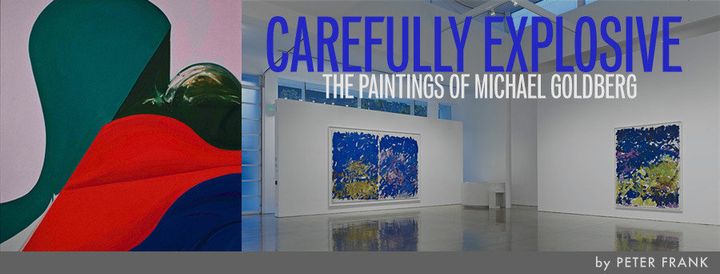
Friends with a vast circle of artists and culturati, passionate and yet logical about his "job" as a maker of paintings, Michael Goldberg was the emblem of a mid-century New York that (to use Yvonne Rainer's phrase) regarded the mind as a muscle. The six decades of paintings he left behind when he died three years ago were as carefully explosive as he was, as expansively private, as rawly nuanced. They were complex to create and are to behold but they are so reasonably vivacious that you walk away from each feeling as if you've concluded a good discussion with someone who took you seriously and taught you something.
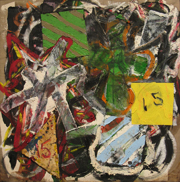
MICHAEL GOLDBERG, Bowery Days, 1993, Oil, pastel, and collage on linen, 38 x 37 1/2 inches, Courtesy Manny SIlverman Gallery, Los Angeles, Photo: Jamie Adams
What in Goldberg's art inspires this reassuring experience? Basically, it's a sense of what you could call natural architecture. No matter how wild the brushstroke, it always falls in a coherent place. There is a simultaneous sense of things collapsing and being (re)built, dissolving and coalescing again, determining a rhythmic structure often defined, but never confined, by the schema (not formula) shared with other paintings in that particular series. Goldberg changed his schemata every few years throughout his career, and some schemata are in and of themselves more persuasive than others; but he never lost his ability to generate a painting so that it seems at once a result of contemplation and a confluence of happy accidents. Goldberg was in this respect the quintessential Abstract Expressionist, fierce in his dedication but unromantic about his task, not merely vomiting heart onto canvas but conjuring ideas out of paint and pulling us into the conjuration at least as much as into the ideas.
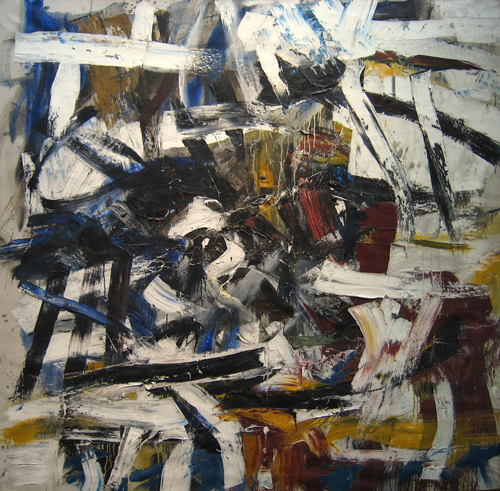
MICHAEL GOLDBERG, Duomo, 1959, Oil on canvas, 81 x 82 inches, Collection of Michael and Eve Steinberg, Courtesy Manny Silverman Gallery, Los Angeles, Photo: Matt Fukushima
"Perpetual Motion," the Goldberg retrospective that ended Sunday at the California State University Long Beach Art Museum, alit on most of the painter's schemata - okay, call them styles - beginning with organic abstract (but suspiciously familiar) forms, moving on to the gestural tumult of high-dudgeon Ab Ex, giving way to stripped-down structures often defined by single immense brushstrokes (several years before Minimal art), and, in this show, jumping to two immense, purlescent monochromatic panels from 1971 laced with lines and shadows and pentimenti. The survey's big hole was in that jump across most of the 1960s, omitting Goldberg's serious if oblique flirtation with figural expressionism and the sexy map-like canvases full of voluptuous drawn trails that immediately preceded the monster monochromes. The subsequent jump from 1971 to 1985 - a period of illness, rehabilitation and renewal - was not as regrettable, and the paintings spanning Goldberg's last two decades churned elaborately and delightfully with scumbles and scribbles (he often seems to be writing as much as painting, although the effects are never calligraphic), surefire experiments with collage, and relatively restrained but ever-glowing palette. Looking at these latter works, you came to realize how much similar subtlety inflects the earlier paintings, whether minimal or maximal. Goldberg was interested not in theatrics but in choreography.
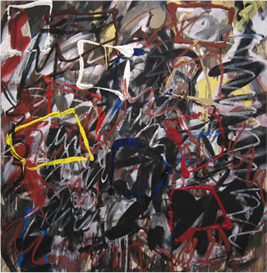
MICHAEL GOLDBERG, Untitled, 1985, Oil on canvas, 60 x 58 inches, Courtesy of Manny Silverman Gallery, Los Angeles, Photo: Jamie Adams
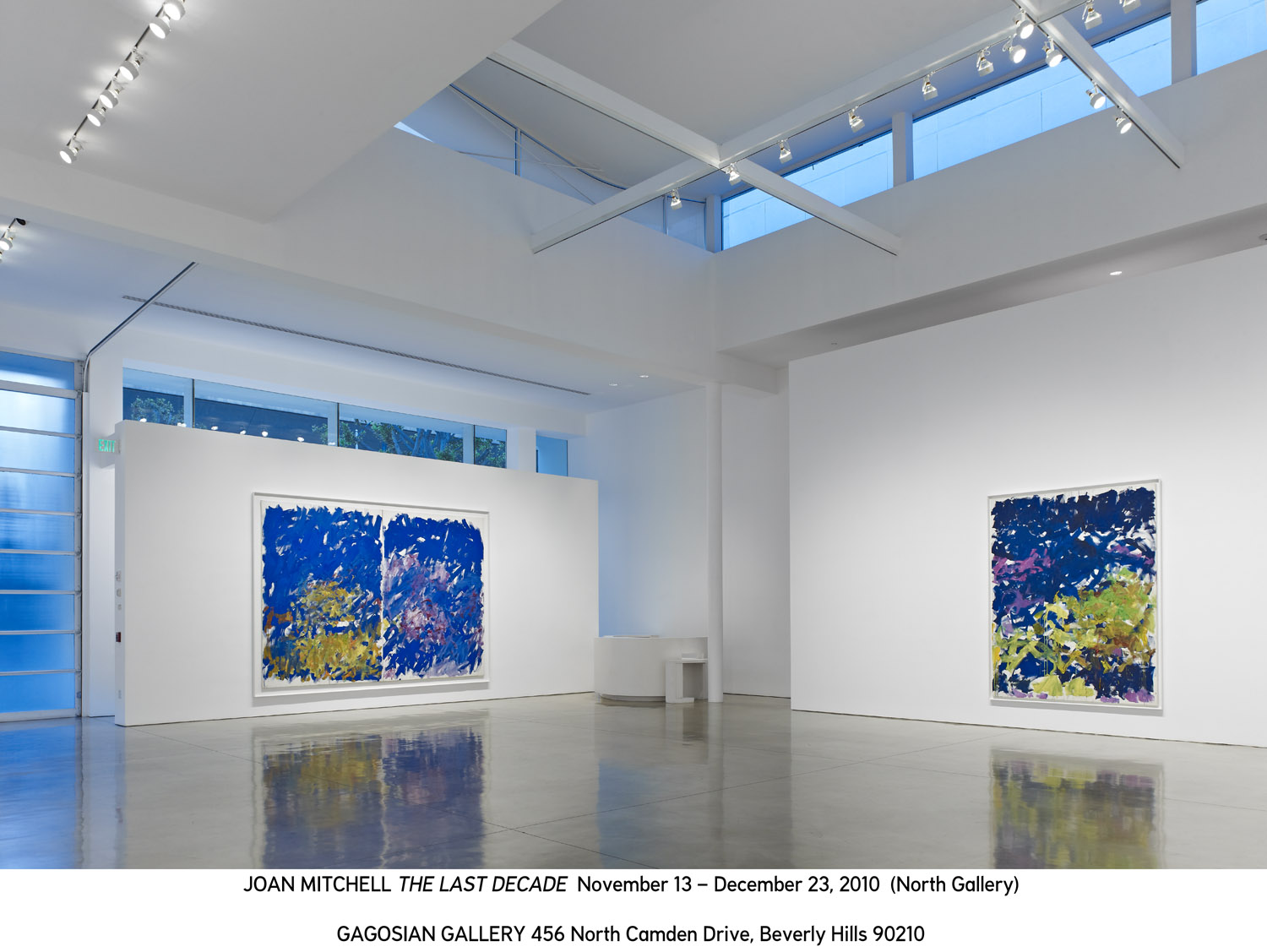
© Estate of Joan Mitchell. Courtesy Gagosian Gallery. Photo: Douglas M. Parker Studio
Up in Los Angeles proper (well, West Hollywood), the Manny Silverman Gallery has echoed "Perpetual Motion" with a show of (mostly) works on paper (mostly) from Goldberg's later years. The joint jumps (through Saturday) no less fervently and gracefully than it did in Long Beach. Silverman had preceded this show with a scattered but powerful survey-let of paintings by Joan Mitchell, Goldberg's New York School coeval (and, for a New York minute, wife). A more pointedly spectacular Mitchell show, comprising works from her last decade, hangs at Gagosian in Beverly Hills (until next Thursday). She was the colorist her ex-husband wasn't, and these mostly huge canvases sing like choirs of color. Mitchell made these paintings in Paris and Vétheuil, by no coincidence the haunts of Claude Monet a century earlier, and they proffer the warm spatial embrace of landscape painting; the space in Goldberg's work doesn't breathe deeply and regularly like this. But Mitchell's brushstroke here (as opposed to her earlier work) is agitated, clustered and ruminative, much like Goldberg's, and articulates no less than his the notating process of a tireless arm.

MATSUMI KANEMITSU, Untitled, 1969, Acrylic on canvas, 36 x 30 inches
Matsumi Kanemitsu was another "Mike" on the New York art scene in the 1950s; he didn't turn up in as many Frank O'Hara poems as did Goldberg, but showing up in even one marks the regard in which he was held. Kanemitsu, born in Utah but raised in Japan, moved to Los Angeles in the early 1960s, coming initially to work at the Tamarind Lithography Workshop; he became as well known for his prints as for his paintings. A small survey of his work (through Saturday) at Sabina Lee Gallery in Chinatown shows Kanemitsu's formal rigor, coloristic brio, and above all his wit, whether in figuration or abstraction or odd combinations of both. (In the late 1960s and early '70s, he seemed to be trying at once to absorb and reinvent Pop Art.) The double orbs of Mickey Mouse's ears, for instance, recur in a series of abstract lithos and a goofy self-portrait.
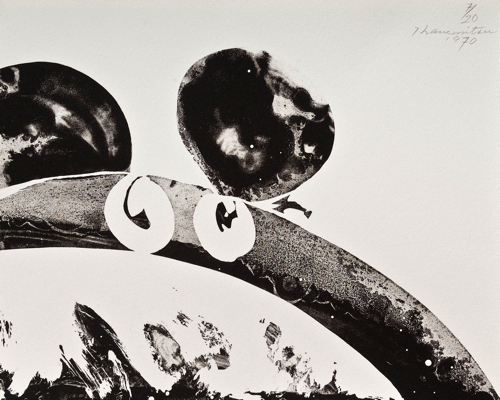
MATSUMI KANEMITSU, Mickey Mouse Series, 1970, Lithograph, 8 x 10 inches

ALBERTO BURRI, Combustione L.A., 1963, Paper, acrylic, corrugated cardboard, combustion, and Vinavil on canvas, 61 x 65 5/16 inches, Fondazione Palazzo Albizzini, Collezione Burri, Città di Castello , Italy, © 2010 Artists Rights Society (ARS), New York/SIAE, Rome
A respected teacher, Kanemitsu was even more broadly regarded in LA than he'd been in New York. Alberto Burri, on the other hand, slipped in and out of Los Angeles almost unrecognized. Well, it wasn't his primary residence: he and his American wife would come here to escape the Roman winters and to a certain extent his international reputation as well. In LA Burri could experiment with few people looking over his shoulder; a postwar pioneer of new materials and processes - at least parallel to, if not influential on, the likes of Robert Rauschenberg - Burri cast a long shadow on the continental avant garde, but received far spottier acknowledgment over here, especially after the '50s. "Combustione: Alberto Burri and America" at the Santa Monica Museum of Art (through Saturday) demonstrates that, in fact, the Italian... painter? Assemblagist? Material manipulator?... had a long, intricate relationship with America, beginning with his internment in a Texas POW camp, where he decided to become an artist. He was shown frequently in New York and various American museums until about the time he bought the Hollywood Hills house, his burlap collages, burnt-plastic surfaces and crackled earth-like reliefs celebrated for the same rough-hewn sensuousness that we admired in the work of Lucio Fontana, Antoni Tapies, and other Mediterranean tachistes. "Combustione" should reawaken that celebration - not only because it reintroduces us to a significant figure in postwar art and ties his work in with his American experience, but because it reveals an enduring freshness to Burri's earlier work in particular, an ability to find elegance in, not just impose elegance on, inelegant substances without obscuring the poignancy of their abject status and the seething, volcanic power of their appearance.
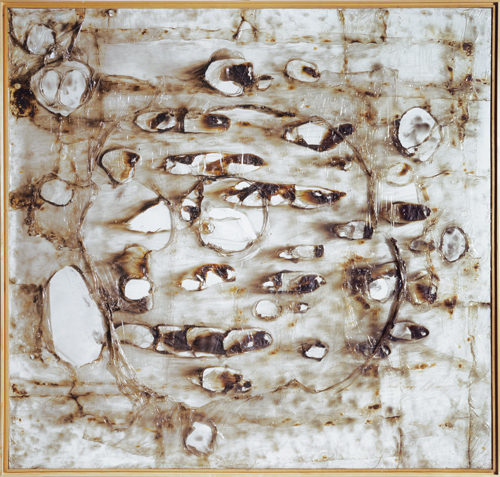
ALBERTO BURRI, Grande Bianco Plastica, 1962, Plastic and combustion on aluminum frame, 74 7/8 x 78 3/4 inches, Fondazione Palazzo Albizzini, Collezione Burri, Città di Castello , Italy,
© 2010 Artists Rights Society (ARS), New York/SIAE, Rome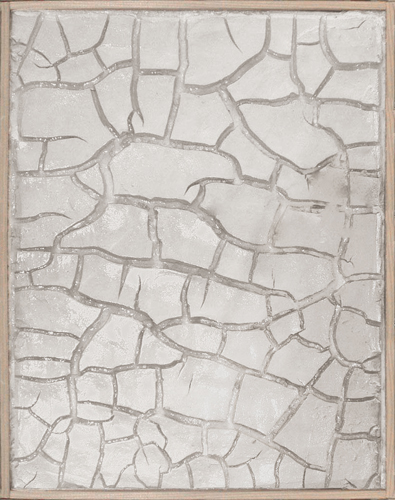
ALBERTO BURRI, Cretto L.A., 1976, Acrylic and glue on fiberboard, 12 13/16 x 10 inches,
Collection of Isabella del Frate Rayburn, © 2010 Artists Rights Society (ARS), New York/SIAE, Rome